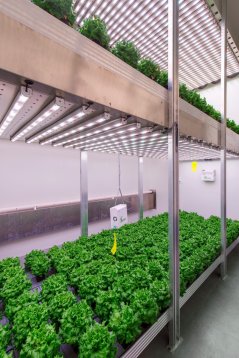
News
A fair comparison between high-tech greenhouses and vertical farming
Vertical farming is often seen as the future of food production. After all, in a closed environment the climate is better controlled and water can be reused. That is correct if vertical farming is compared with, for example, an open field. But what about a high-tech greenhouse: are the benefits of vertical farming still just as great?
The Greenhouse Horticulture and Flower Bulbs Business Unit of Wageningen University & Research (WUR) discovered that the disadvantages of vertical farming often outweigh the advantages. David Katzin: “When assessing the opportunities of vertical farming, do not look with rose-colored glasses, but with realistic glasses.”
Vertical farming is the cultivation of a crop in a closed environment, for example in a container. The cultivation does not come into direct contact with the outside air and sunlight. That has many advantages. This makes it possible to control the cultivation in a very targeted manner (due to the absence of outside influences). And cultivation in a vertical farm has several advantages for reducing damage to the environment: less crop protection is needed and water and fertilizers can be reused.
As a result, there is a lot of enthusiasm - especially in science - about vertical farming. But vertical farming is not necessarily the sustainable future of food production. For example, a lot of energy is needed to grow the crops, due to the use of artificial light, and it is very capital intensive. According to WUR researchers, it is therefore good to compare vertical farming with other forms of food production, and in particular with high-tech greenhouses. Even in modern greenhouses, water and fertilizers are reused and less or no chemical crop protection is used. And don't forget: a greenhouse benefits from (free) sunlight.
Two researchers from WUR (David Katzin and Cecilia Stanghellini) therefore wrote an article for the scientific journal Journal of Cleaner Production in which vertical farming is compared with high-tech greenhouse horticulture on a number of variables. The article, 'The dark side of lighting', is already available. The researchers compared available data and knowledge about both forms of horticulture.

They showed that the disadvantages of vertical farming - especially the high energy consumption - often outweigh the advantages. Even the benefit that vertical farming offers, namely making it possible to grow food anywhere in the world, is often not a benefit to the ecological footprint. An example: lettuce grown in a vertical farm in the Netherlands can have a larger footprint than if that lettuce is grown in a greenhouse in southern Italy and transported to the Netherlands by truck.
Since it is a new technology, there is still very little data on vertical farming in practice. However, the researchers have been able to outline the boundaries of vertical farming based on known scientific principles. They showed that, when considering all possible alternatives, it is almost never desirable to lose the free light of the sun.